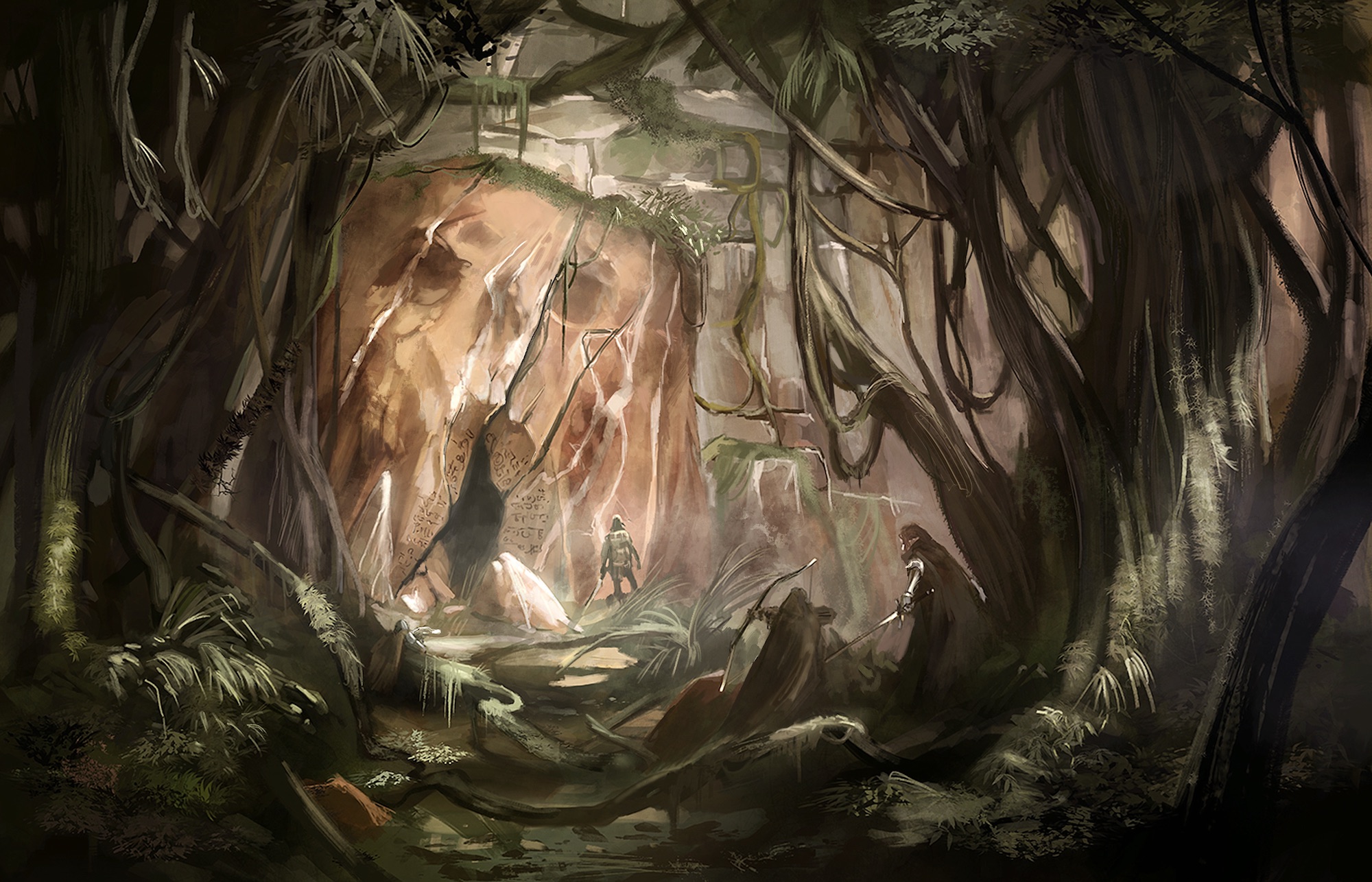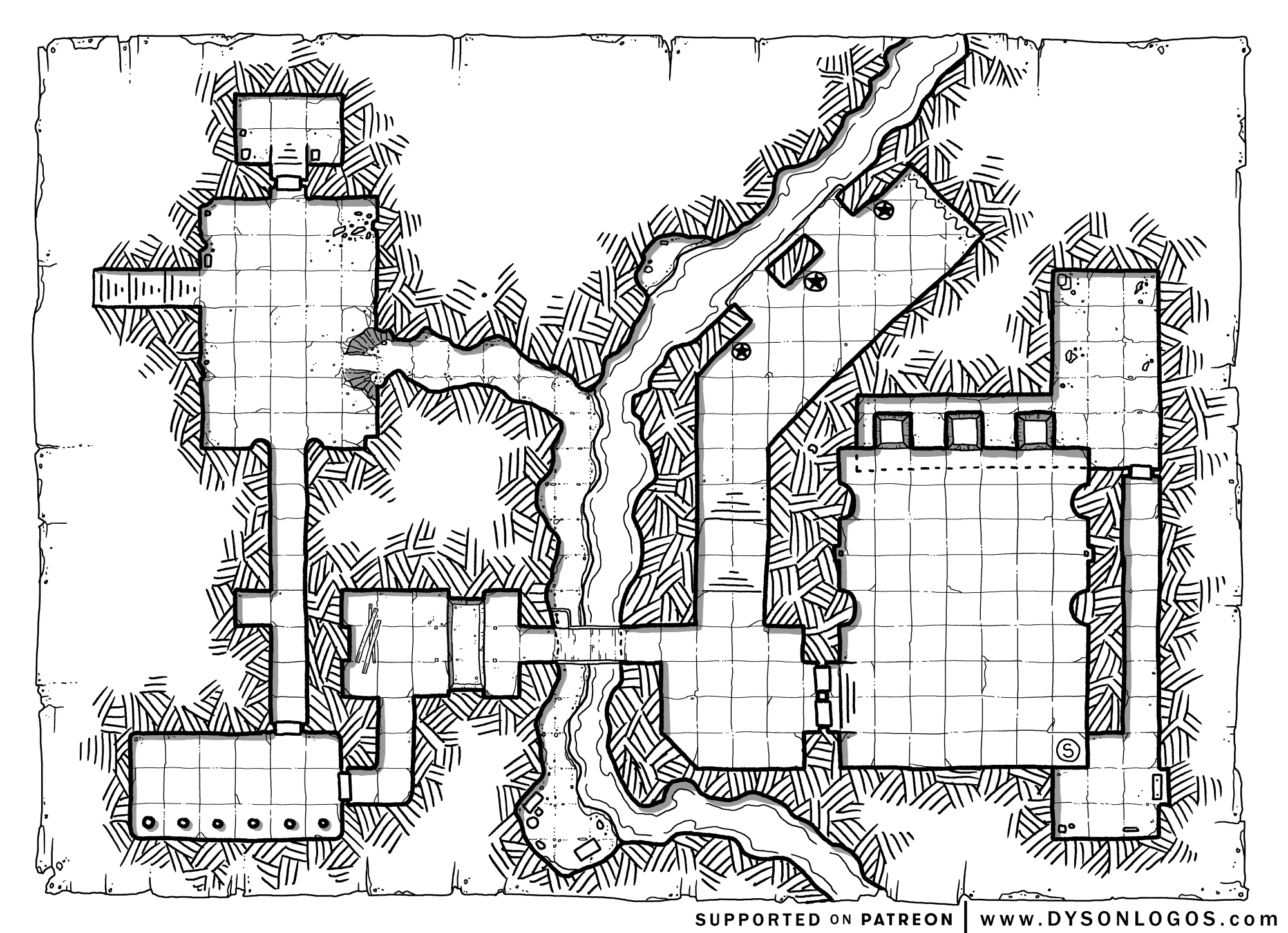New to Sly Flourish? Start Here or subscribe to the newsletter.
The Minimum Viable D&D Game
by Mike on 14 December 2020
What is the minimum preparation we need to run a great D&D game? In a previous article we've explored what we might do if we spend an entire day preparing for a D&D game and Return of the Lazy Dungeon Master already boils down game preparation so we can spend less time preparing for our D&D games, instead focusing on what we need to improvise the game when we run it.
Today we're going to start from the ground up, looking at what preparation we might put together to have enough to run a great game.
The D&D Essentials Kit is a great example of the minimum you need to play D&D. The kit includes fourteen adventure locations that take characters from 1st to 6th level. Many of these adventures are only two pages long. We can learn a lot from the Essentials Kit as a model of the pure simplicity of D&D.
How much do we really need to have ready for our D&D games so we and our players can have some fun?

A Strong Start
Second only to reviewing the characters, the strong start is a critical component of a D&D game. How does the game begin? What happens to draw the players into the game? What hooks the characters into the rest of the adventure? We often don't need more than a sentence to describe this but it's a critical sentence. Maybe it's big. Maybe it's small.
Here are some example strong starts:
- Two parents weep for their teenage child who has gone off to make a name for themselves by exploring Nightstone Cave and never came back.
- A bandit with the heads of three village elders from other villages rides into town demanding that the town turn over all of their food and wealth or their own elder's neck will fall under the bandits' knives.
- Miners return to town describing a collapsing cave revealing an ancient drow vault.
- A carnival has come to town operating out of an ancient amphitheater and villagers have begun to disappear after the performances.
- A comet appears in the sky that reveals a mysterious doorway on the nearby mountainside. The locals fear what may step through and ask the characters to investigate it.
- A recent rockslide has revealed an ancient dwarven crypt and skeletons have been seen nearby.
We can think of our strong starts under the same lens as the rest of our minimum viable D&D game. What is the minimum a strong start needs to hook the characters?
Discoveries
Combat, interaction, and exploration are the pillars that make up a D&D game and exploration is often about discovery. What are ten things the characters can learn in the next game? This is a core step from Return of the Lazy Dungeon Master called secrets and clues. Here are ten example secrets and clues for that last strong start on the list above.
- The dwarves had an ancient burial site in the side of a nearby mountain. Erosion has recently revealed its entrance.
- Not all dwarven gods are good. Some were downright sinister.
- The uncovered dwarven crypt was in worship of Dumathoin, the god of buried secrets.
- The dwarven crypt is full of traps and hazards.
- One of the buried dwarven heroes is said to have once held a powerful mace capable of smashing stone.
- A band of grave robbers known as the Ghostbloods tried to loot the site. None returned.
- A drow necromancer was said to have taken over the site. Since then undead have been seen walking in the dead of night around the area.
- The dwarven burial site was maintained for centuries. There are crypts and sepulchers below the main halls.
- A monster-infested roaring river flows through the dwarven ruins.
- Rumors whisper of a dwarven ghost who still haunts the crypts.
After our strong start, writing out ten secrets and clues gives us the material we need to fill in the story as the characters engage in their adventure.
A Dungeon
Often adventures begin or lead to an interesting location to explore. Many times these adventure locations are dungeons, a core component of D&D. Whenever I need a location, I hit up Dysonlogo's maps and grab the first map that fits what I need. Here's a cool one we can use that should last for a session and fits the secrets we have above:

Locations are more than maps, though. You'll want to list out the interesting features the characters may run into in these locations. In Return of the Lazy Dungeon Master I recommended an evocative name and three features for each location. That may be more than we need for our minimum viable D&D game. An evocative name alone might be enough to fire up your imagination when you need it.
Here are some example location descriptions:
- Desecrated Hall of Dwarven Heroes
- Slippery Sinkhole
- Dark Altar of Myrkul
- The Pillars of Dumathoin History
- The Crawling Moat
- The Smuggler's Cove
- The Hall of Roaring Kings
- The Sunken Sepulchers
If we're feeling crafty, we can write these names right onto the map so we have a key.
Monsters
A good minimum viable D&D game is all about delving into dungeons and fighting monsters. Often, when we want to put a game together, we can start with the Monster Manual, find a monster we like, read about it's lair, and build our minimum viable adventure around that. The Monster Manual is a great place to start to get inspired for any adventure.
Here are some fun monsters around which you can build a fun adventure:
- Hibernating ankhegs
- Burrowing azers
- A hunting Behir
- Ravenous bugbears
- The solitary cyclops
- Expanding ettercaps
- A helpful hag
- The sequestered medusa
- A disguised lamia
- Terrorizing troglodytes
For our map above, we'll go with decrepit skeletons, murderous bandits, devouring carrion crawlers, and a raving specter. We can also drop in a sinister drow necromancer by reskinning a cult fanatic.
NPCs
Fighting monsters isn't the only fun to be had in D&D. In fact, many players prefer NPC interaction to combat or exploration. We should always drop in an NPC or two into our adventures so the characters have people to interact with. When in doubt, use Donjon's random NPC generator to pull up some NPCs and jot them down in your notes.
Here are some interesting NPCs I generated using the Donjon NPC generator:
- Harrey Gysby. Male Human Peasant. Harrey is fair in appearance, with short silver hair and narrow blue eyes. He wears sturdy clothing and a wide-brimmed hat. Harrey has red fox named Brose.
- Almar. Male Dwarf Monk, LG. Almar has a round face, with red hair and green eyes. He wears simple clothing and wields a bo (quarterstaff) and sai (dagger). Almar is loyal and gentle.
- Ancin. Male Half-elf Cleric, LN. Ancin has gray hair and blue eyes, and a straight moustache. He wears studded leather and wields a light hammer and sickle. Ancin seeks to save his family from financial ruin.
- Galaser. Female Elf Rogue, LN. Galaser has a round face, with messy auburn hair and gray eyes. She wears studded leather and wields a shortsword and darts. Galaser suffers an acute fear of death.
- George Pycey. Male Human Fighter, LE. George has golden hair and hazel eyes. He wears hide armor and wields a war pick and hand crossbow. George has an animal companion, a badger named Rende.
For our dwarven crypt adventure we'll go with the dwarven ghost Almar, a former dwarven monk who protects the crypt and hates the defilement of the drow necromancer.
Treasure
Much of the fun in D&D comes from the tangible rewards for adventure. For our minimum viable D&D game, a quick roll for some random treasure may be enough. Donjon.bin.sh has us covered again with an excellent random treasure generator built from the tables in the Dungeon Master's Guide. Run it a few times until you find a treasure hoard that excites you and paste that into your notes.
Here's a suitable hoard for our dwarven crypt adventure:
2100 cp, 1500 sp, 50 gp, Bolt of Fine Cloth (25 gp), Feathered Ribbon (25 gp), Pewter Hairpin (25 gp), Ceramic Urn (25 gp), Polished Stone Coffer (25 gp), Feathered Shoes (25 gp), Slippers of Spider Climbing (uncommon, dmg 200), +1 Weapon (shortbow) (uncommon, dmg 213)
The Minimum Outline
Our minimum viable outline comes very close to the eight steps fro Return of the Lazy Dungeon Master, only omitting the steps "review the characters" and "outline scenes". Those two steps also have something to offer for our game and don't take a lot of extra time. It turns out the eight steps from Return are pretty close to our minimum viable D&D game already.
When you think of your own D&D games, what are the steps you find most vital? What's the minimum you need to run your own game? For the thought experiment in this article, I've come to the following:
- Develop a strong starting scene.
- Write out ten secrets and clues the characters may discover.
- Grab a map and jot down ten to twelve evocative location names.
- Pick some monsters to inhabit our location.
- Drop in one or more NPCs the characters can talk to.
- Add some interesting treasure.
That's often enough to get a game going. The rest will play itself out as the players get involved and the story starts running free at the table.
Related Articles
- The Eight Steps of the Lazy DM – 2023 Review
- Prepare a D&D Game in 15 Minutes
- Using the Lazy DM's Eight Steps At the Table
Share this article using this link: https://slyflourish.com/minimum_viable_dnd_game.html
Subscribe to Sly Flourish
Subscribe to the weekly Sly Flourish newsletter and receive a free adventure generator PDF!
More from Sly Flourish
Sly Flourish's Books
- City of Arches
- Return of the Lazy Dungeon Master
- Lazy DM's Companion
- Lazy DM's Workbook
- Forge of Foes
- Fantastic Lairs
- Ruins of the Grendleroot
- Fantastic Adventures
- Fantastic Locations
Have a question or want to contact me? Check out Sly Flourish's Frequently Asked Questions.
This work is released under a Creative Commons Attribution-NonCommercial 4.0 International license. It allows reusers to distribute, remix, adapt, and build upon the material in any medium or format, for noncommercial purposes only by including the following statement in the new work:
This work includes material taken from SlyFlourish.com by Michael E. Shea available under a Creative Commons Attribution-NonCommercial 4.0 International license.
This site may use affiliate links to Amazon and DriveThruRPG. Thanks for your support!









